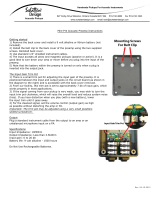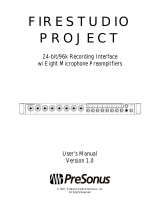
8
USB OPERATION:
Connect your analog jacks and external power supply first. If you are using one of the analog outputs
for local low latency monitoring, connect that to your monitor system or headphones. Next, set the
front panel controls for proper operation as per the previous sections. Then connect the USB cable to
the appropriate input on your computer and lastly to the USB connector on the USB Dual Pre.
Once the USB connection is made and your computer is on, the USB interface circuitry will be po-
wered by your computer over the USB bus and the unit will automatically connect and try to set your
computer “Default Audio Device” to be “USB Audio CODEC”. Usually the computer will do this auto-
matically whenever a USB device is first connected, but it is sometimes necessary to make the
selection manually. The same settings may need to be made in your particular audio application as
well (Check your application instructions). These settings should be made while the two units are
connected and powered on. Select one of the following sound recording (input) settings:
WINDOWS 98SE: Settings => Control Panel => Multimedia
Choose the preferred device: “USB Audio Device”
WINDOWS XP: Settings => Control Panel => Sounds and Audio Devices => Audio.
Choose the mixer device: “USB Audio CODEC”
or Programs =>Accessories =>Entertainment =>Volume Control=> Options=> Properties
Choose the mixer device: “USB Audio CODEC”.
WINDOWS VIsta: Settings => Control Panel => Sound => Playback Tab and Record Tab.
Choose: “USB Audio CODEC”
Mac OS9.1+: Control Panels => Sound.
Choose: “USB Audio CODEC”
Mac OS10+: System Preferences => Sound.
Choose: “USB Audio CODEC”
Your computer audio output “Speaker” is now set to be the “USB Audio CODEC” and playback audio
is routed to the USB Dual Pre. This must be done while the USB Dual Pre is connected to the
computer and powered on. After the above settings are made, your computer will automatically
reconfigure itself back to these settings every time the USB Dual Pre is reconnected to the computer.
At this point your recording software will select and control which channels are being recorded and
which channels are being monitored. There are many computer recording software packages availa-
ble today that allow for multi-track recording. If you are using multiple units and connecting more than
one over the USB bus, they will appear as “USB Audio CODEC 1”, “USB Audio CODEC 2”, etc. in
your recording application. Please refer to your recording software documentation for the best way to
assign channels and set recording and monitoring parameters.
Latency, the time delay between your audio input and the USB output to your computer, is very short
(under 2 milliseconds) in the USB Dual Pre. The latency of your recording software and computer
software drivers can be much more than this. Typically on a Mac the core audio interface has low
latency so this is usually not an issue. USB audio drivers that come with Windows can have enough
latency to cause a discrete delay when monitoring live. If this becomes an issue there are low latency
ASIO drivers available that can greatly reduce your Windows audio latency. Two current resources
for low latency ASIO drivers that will work with the USB Dual Pre are: www.asio4all.com
and
www.usb-audio.com













